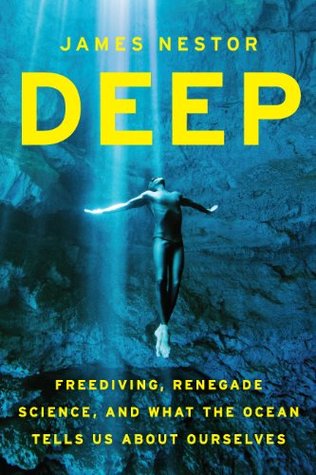More on this book
Community
Kindle Notes & Highlights
by
James Nestor
Read between
September 16 - September 23, 2022
I watch several more competitors attempt dives to around three hundred feet. Many can’t make it and turn back. They resurface with blood running down their faces from their noses, unconscious, or in cardiac arrest. The competition just keeps going on. And, somehow, this sport is legal.
Other than BASE jumping—parachuting off buildings, antennas, spans (bridges), and earth (geological formations)—freediving is the most dangerous adventure sport in the world. Dozens, perhaps hundreds, of divers are injured or die every year.
Scientists have discovered that every cell in the human body also contains an electrical charge. Tibetan Buddhist monks who practice the Bön tradition of Tum-mo meditation have learned to focus these cellular charges to warm their bodies during bitterly cold winters. Researchers in England have discovered that by controlling the output of cellular charges in our bodies, humans can not only create heat but treat many chronic diseases.
Every year on the same day, at the same hour, usually within the same minute, corals of the same species, although separated by thousands of miles, will suddenly spawn in perfect synchronicity.
“Do I look like some adrenaline junkie?” he says, sipping water from a steel bottle, wearing his most monk-like expression. “Skydiving, jumping with bikes. I hate all that shit!” he says. “Freediving with sharks is the opposite of an adrenaline sport. You need to be calm, balanced. You need to know yourself. Being relaxed and in control is the only way you can do it.”
Dolphins can detect the shape, position, and size of larger objects from up to six miles away. Their echolocation is so powerful and sensitive that it can penetrate over a foot deep into sand; it can even “see” beneath skin. Dolphins can peer into the lungs, stomachs, and brains of the animals around them.
Phytoplankton, the microscopic algae that make up at least half of all biomass in the ocean, absorb about one-third to one-half of all CO2 and produce more than 50 percent of all the Earth’s oxygen. As the oceans warm, phytoplankton will die off. Carbon dioxide levels will rise and oxygen levels will fall.
bioluminescence, the chemical production of light by living organisms. About 80 to 90 percent of ocean life, from bacteria to sharks, use some form of it.
For an animal to be processed as food, it must contain less than 2 parts per million of PCBs. Any animal that contains 50 ppm of PCBs must, by law, be considered toxic waste and be disposed of in an appropriate facility. Dr. Roger Payne, an ocean conservationist, analyzed sea life for PCBs and found that orcas had about 400 parts per million of PCBs—eight times the toxic limit. He found beluga whales with 3,200 ppm of PCBs, and bottle-nosed dolphins with 6,800 ppm.
It was discovered much later that the deep pelagic realm, those waters from about 13,000 to 35,000 feet, housed the largest animal communities, the greatest number of individuals, and the broadest animal biodiversity of not only the ocean but any place on Earth.
freediving was about connecting with the underwater environment, looking more keenly at your surroundings, focusing on your feelings and instincts, respecting your limits, and letting the ocean envelop you—never forcing yourself anywhere for any reason. This was a spiritual practice, a way of using the human body as a vessel to explore the wonders in the Earth’s inner space.
If you haven’t figured it out already, freediving can be a dangerous hobby and a lethal sport. Many freedivers delude themselves into thinking otherwise. As a result, many die every year in accidents that are easily preventable. The crackerjack, no-bullshit approach offered by Eric Pinon at Performance Freediving International and Ted Harty at Immersion Freediving has been a lifesaver for me and thousands of other beginning divers. If you want to go deep, start at the top. See these guys. And remember: Know your limits. Never dive alone. Always stay in control.


